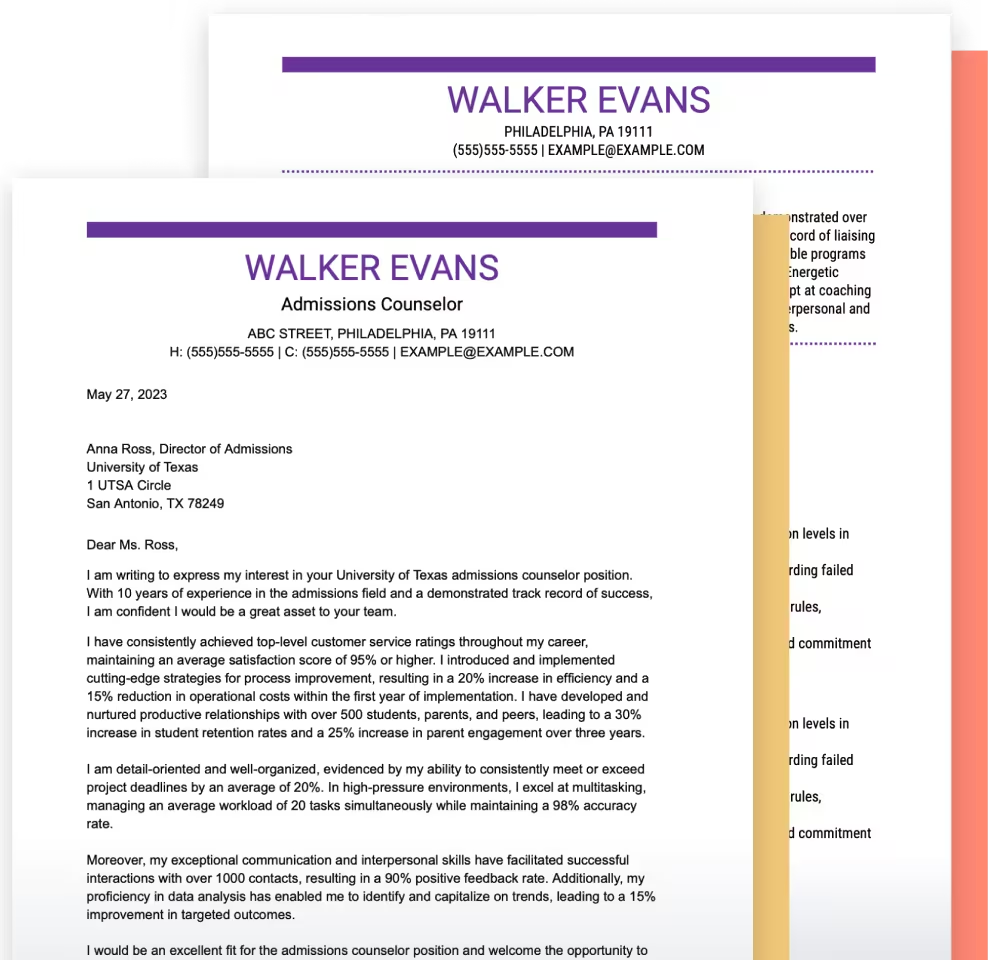Freelancer Resume Examples & Templates

- 30% higher chance of getting a job‡
- 42% higher response rate from recruiters‡
Our customers have been hired at:*Foot Note
Freelancing offers the freedom, flexibility, and autonomy to shape your own career. To land new clients, you’ll need a compelling resume that showcases your skills and expertise.
In this guide, we’ll explore strategies for crafting a freelance resume that tells a story of adaptability and success and proves your value in a competitive job market.
If you’re ready to build your freelancer resume, the MyPerfectResume Resume Builder can help you create a tailored client-focused resume that unlocks new opportunities.
You can start by editing the freelancer resume examples above or explore our library of professional resume templates to find one that matches your style.
Freelancer Resume Example (Text Version)
Nathan Garcia
Philadelphia, PA 19111
(555) 555-5555 – example@example.com
Professional Summary
Results-driven finance consultant with eight years of experience delivering financial strategies that drive profitability and operational efficiency. Proven track record of optimizing financial processes, reducing costs, and increasing revenue. Skilled in economic analysis, budgeting, and risk management, committed to aligning financial objectives with business goals. Achieved a 20% increase in client profitability through data-driven financial solutions and reduced operational costs by 15% through process optimization.
Skills
Financial analysis
Strategic thinking
Tableau, Power BI
Financial modeling
Microsoft Excel (Advanced)
Risk management
Budgeting and forecasting
Financial analysis
Work History
09/2023 to Current
Finance Consultant
PFM Financial Advisors LLC – Philadelphia, PA
- Advise clients on financial planning and investment strategies, increasing revenue by 15%.
- Conduct in-depth financial modeling and forecasting, enhancing clients’ long-term financial stability.
- Develop risk management strategies that mitigate financial risks by 18% across multiple client portfolios.
06/2020 to 08/2023
Freelance Finance Analyst
TEKsystems – Philadelphia, PA
- Enhanced financial reporting processes, reducing the month-end closing time by 20% and improving data accuracy.
- Conducted cost-benefit analyses that led to a 15% reduction in operational expenses while maintaining productivity.
- Developed financial models that improved cash flow forecasting accuracy by 25%, supporting better budgeting decisions.
06/2017 to 05/2020
Junior Finance Consultant
EY – Philadelphia, PA
- Supported senior consultants in financial assessments, contributing to a 12% improvement in client ROI.
- Analyzed financial data to identify cost-saving opportunities, reducing operational expenses by 8%.
- Prepared comprehensive financial reports that increased transparency and client confidence.
Education
MBA: Quantitative Finance and Risk Management
Temple University – Philadelphia, PA
Bachelor of Science: Finance
Temple University – Philadelphia, PA
Certifications
Certified Financial Consultant (CFC)
Chartered Financial Analyst (CFA) Level II
Important Resume Sections
Contact details
The first thing a recruiter will see is your resume header with your name and contact information. Make the header noticeable while keeping it professional and sleek, and remember to include the following information:
- Full name at the very top on larger font
- Phone number
- Email address
- Physical address (city and state will suffice)
- LinkedIn profile or link to professional portfolio
Resume summary
At the top of your resume, just below your contact information, will be your resume summary. This is your elevator pitch. Use this section to introduce yourself; include your title, your level of experience, the specific type of work you’ve done and what you can bring to the table.
If recruiters only read your summary, you want it to make an impression. Here’s an example of how you can do that:
“Detail-oriented graphic designer with over 10 years of experience delivering compelling designs for clients across various industries. Skilled in branding and UX/UI design, with a proven track record of translating client visions into impactful visuals. Adept at managing multiple projects and collaborating with diverse teams.”
Skills
The resume skills section is where you’ll list your skills in a scannable format for recruiters to see. You can add hard skills, such as software proficiency or technical expertise, and soft skills, such as leadership, time management, and teamwork.
You can also add transferable skills, mainly if you use your resume to apply to various industries or come from a different background. Transferable skills can include certain computer software or safety training, for example, as well as most soft skills.
Work history
Your work history is the main section of your resume. It’s where you’ll list your work experience, as well as the specific tasks you performed while on the job.
While a freelancer career doesn’t follow the traditional path of roles within a company, this is still where you’ll include past projects and your tasks. Whether you’ve designed branding, built websites, written copy, or managed marketing campaigns, every project counts.
The key is highlighting impact rather than just listing tasks.
Instead of:
“Created marketing materials for clients.”
Detail your tasks like this:
“Developed marketing collateral that boosted client sales by 25%.”
If your freelance work spans industries or roles, choosing the right resume format, such as a functional or hybrid format, lets you emphasize skills over chronology, ensuring your most relevant qualifications stand out.
Education
The relevance and importance of your education section will largely depend on the stage of your career. If you’ve been in the field for over a decade, you might not even need an education section — unless it’s highly relevant to your work, such as software development or legal counseling.
If you’re wondering how to list a degree on your resume, consider your career stage and how relevant each degree is to your career and the job you’re applying for.
For example, if you’re a recently graduated freelancer, your education section might be the main focus of your resume. In that case, you can add relevant coursework, special projects you’ve worked on, and even extracurricular activities that have contributed to your skills.
On the other hand, it’ll look different if you’re more experienced and have multiple degrees. Your education section should go below your work experience. Organize your degrees in reverse chronological order, and feel free to omit earlier degrees or those that aren’t relevant to the work you do now.
See why MyPerfectResume is a 5-star resume builder
Action Words for Your Resume
Using action verbs on your resume is very important to portray confidence and represent what you’ve done in past roles concisely and accurately. Instead of using vague terms like “helped,” “took part in,” or not using verbs at all, use action verbs such as:
- Advise
- Analyze
- Code
- Collaborate
- Conceptualize
- Counsel
- Create
- Defend
- Design
- Draft
- Edit
- Engineer
- Illustrate
- Implement
- Organize
- Program
- Strategize
- Write
There are hundreds of possible action verbs to use in your resume. For more examples and ideas on how to incorporate them, check out our resume examples page.
Best Skills for Your Resume
Listing skills on your resume is crucial. It gives recruiters additional information about what you can do and how you can fit into their teams and processes.
Skills go beyond your work history. Include abilities you may not have had the chance to use in previous roles, such as coding you may have learned as a hobby, or those that don’t show elsewhere, such as proficiency in a second language.
Here is a wide variety of examples of skills you can add to your freelancing resume:
- Adobe Creative Suite
- Adaptability
- Attention to detail
- Budget management
- Client relationship management
- Contract writing
- Copyediting
- Data analysis
- Graphic design
- Market research
- Multitasking
- Negotiation
- Online community engagement
- Proposal writing
- Python
- SEO research & analysis
- Social media marketing
- Stress management
- UX design
Skills vary significantly from one candidate to another, and the ones you choose to list will vary depending on the job as well. Use our resume skills generator to create a relevant list of skills to give your resume that additional push.
Certifications for Your Resume
You can also add a section to list your certifications or licenses. These add a layer of expertise and skill to your candidate profile, especially if they’re highly relevant to the role you’re applying for.
As a freelancer, it’s crucial to demonstrate you stay up to date on the latest developments in your field, whether new technologies or modern approaches to problem-solving.
Here are a few examples of certifications:
- 3D Modeling & Animation Certification
- Adobe Certified Professional
- AWS Certified Solutions Architect
- Financial Planner Certification
- Copyediting Certificates
- Google Digital Marketing & E-commerce Certification
- Google UX Design Professional Certification
- Grant Writing Certification
- iOS App Development Certification
- Python Programmer Certification
- Resume Writer Certification
- Teaching English as a Foreign Language (TEFL) Certification
Pair your resume with a matching cover letter
FAQ
Do I need a resume as a freelancer?
Yes! Although you may not look for jobs traditionally, a resume is still a valuable tool to present yourself to potential clients. It’s a quick and familiar way for them to assess your qualifications and experience and decide if they want to work with you.
Also, freelancers can apply for positions inside a company. These could be in the form of a temporary job or on a project-by-project basis. These positions still follow standard hiring procedures and require resumes, cover letters, filling out applications, and an interview stage.
Having your resume ready is important so you can jump at any opportunity quickly and show what you can bring to the table.
Should I include free or volunteer work on my freelance resume?
You should definitely add volunteer work to your resume, especially if that work is highly relevant to your career. For example, copyediting for a non-profit organization as a writer or designing their website as a professional web developer.
This work not only adds to your creditworthiness but also shows your commitment to your community, which could be very important to certain clients.
Do freelancers need cover letters?
The requirement for a cover letter depends mainly on the client or company, so the short answer is yes. We recommend having a cover letter template ready in case you need to write one for a new opportunity.
However, as a freelancer, we also recommend learning how to write a letter of intent or interest to approach potential clients. A letter of intent expresses your interest in working with a particular company or interest, whether it be because your values align or because you think they can use your services.
Best Practices
- Describe your past roles and successes by using measurable achievements. For example, instead of writing “Worked with a local restaurant,” write: “Designed the brand identity of a local restaurant, including the overall color scheme, logo, flyers, and inside decor.”
- Use action verbs to accurately and concisely describe your tasks in past roles.
- Incorporate keywords in the job description, as many companies filter applications using Application Tracking Systems (ATS).
- Tailor your freelancing resume to the specific job or project you’re applying for, including the most relevant skills, certifications, and experience.
- Format your resume in a clean and organized manner that highlights your most important sections and grabs the attention of recruiters.
- Lie about your qualifications or experience. Transparency is crucial for both finding a job and being successful at it. Lies can backfire quickly, even during the first interview.
- Exaggerate your skills and certifications or use arrogant language to describe your abilities. It can come off as unprofessional and might be tough to live up to.
- Include irrelevant information, such as age, race, or skills that are unrelated to the job.
- Forget to proofread. Even a small typo could get your resume skipped either by an ATS or by recruiters.
Top Tips for Freelancer Resumes
Start with a strong resume summary
It’s important to start your resume with a strong resume summary that captures the recruiter’s attention and efficiently summarizes your potential as a candidate. This will most likely be the first impression a recruiter or employer gets of you, and in some cases, the only one, so make it count.
Here’s an example of what a good resume summary looks like, including your title, your most relevant experience, and a more specific example of what you specialize in or what you can do for the company:
“Freelance business consultant with 5 years of experience helping businesses optimize operations and drive growth in the digital space. Specialized in process improvement and strategic planning to boost efficiency and profitability. Passionate about delivering data-driven solutions tailored to client goals.”
Highlight relevant coursework and projects
Beyond your degrees, you can include specific courses in your resume, especially if you have little to no work experience and if those courses are highly relevant to the position. You can also add stand-alone courses that you’ve taken to refine your craft or stay up to date on your field.
You can also list projects on your resume that have been central to your development and experience, such as the complete rebranding of a company’s identity or an SEO audit of a large website.
Use action verbs and quantifiable achievements
Use action verbs to keep the resume dynamic when describing your tasks in your work history, education, or projects section. Most importantly, use quantifiable achievements to discuss your success or explain your duties in detail.
Quantifiable achievements leave little room for interpretation and give exact details on how much you can actually provide for the client or company. Here are some examples of measurable accomplishments to follow:
- “Increased organic website traffic by 150% through SEO-driven content strategies for multiple clients.”
- “Developed 20+ e-commerce websites that increased client sales by an average of 35% within six months.”
- “Increased conversion rates by 30% through persuasive sales copy and A/B tested landing pages.”
- “Automated reporting systems, cutting manual data entry time by 60% and improving accuracy.”
Include a skills section
Most resumes should include a skills section that lists the main skills an applicant has, with hard skills related to the position and soft skills that round out an applicant’s profile as an employee, a leader, or a self-managed freelancer.
Depending on the stage of your career or your overall level of experience, the skills section could be placed higher on your resume or in a more prominent position.
Proofread and get feedback
Proofread your resume at least twice to ensure there are no grammatical errors, typos, incorrect dates, or glaring omissions that could impact your job search. More importantly, ask for feedback from colleagues, mentors, or even a recruiter if you’re working with one.
Nowadays, an ATS-friendly resume is necessary, and a small mistake could be costly when going through these filters. They may not catch important keywords if the resume is miswritten or used in a different format, such as in a photo instead of text.
How we reviewed this article
Since 2012, we have helped more than 11 million job seekers. We want to make your career journey accessible and manageable through our services and Career Center’s how-to guides and tips. In our commitment to bring you a transparent process, we present our Editorial Process.

